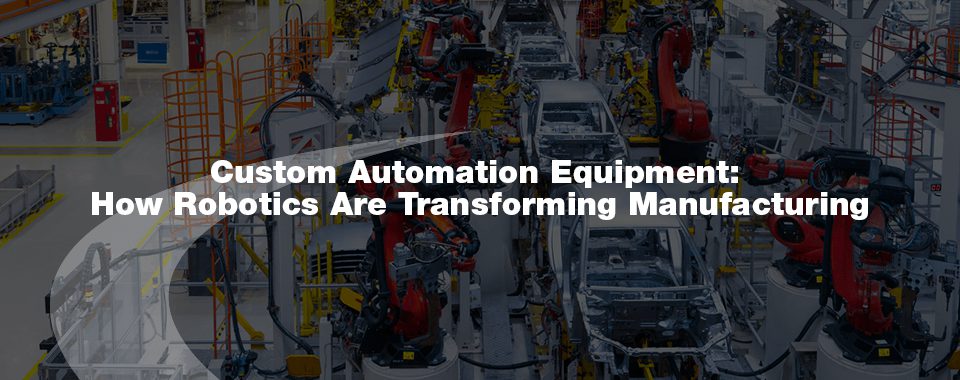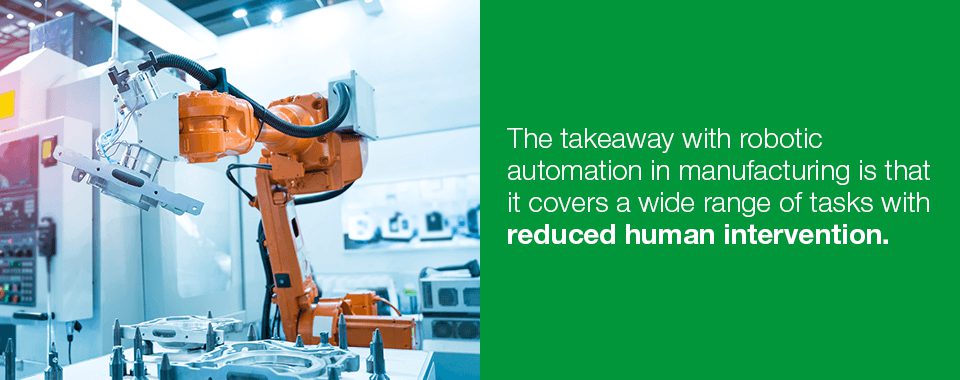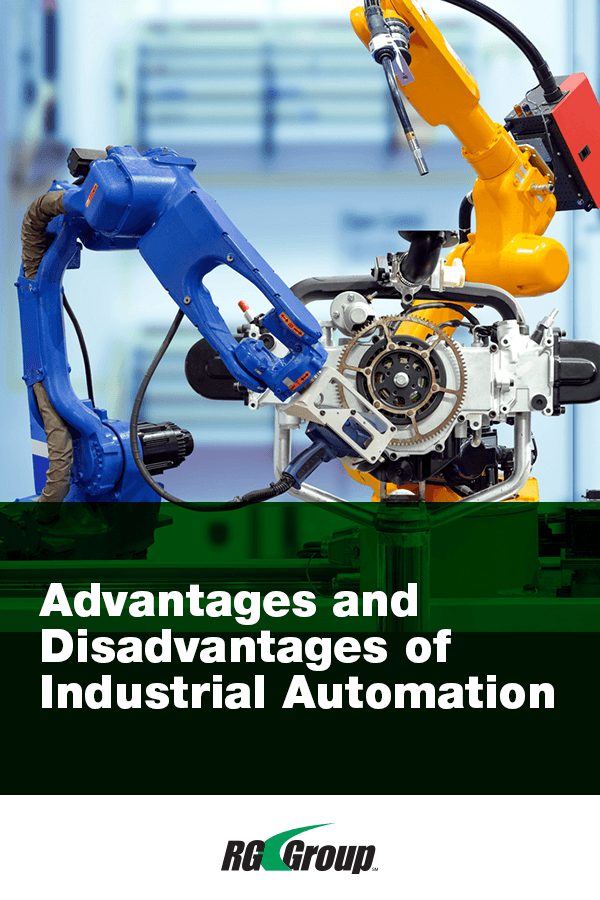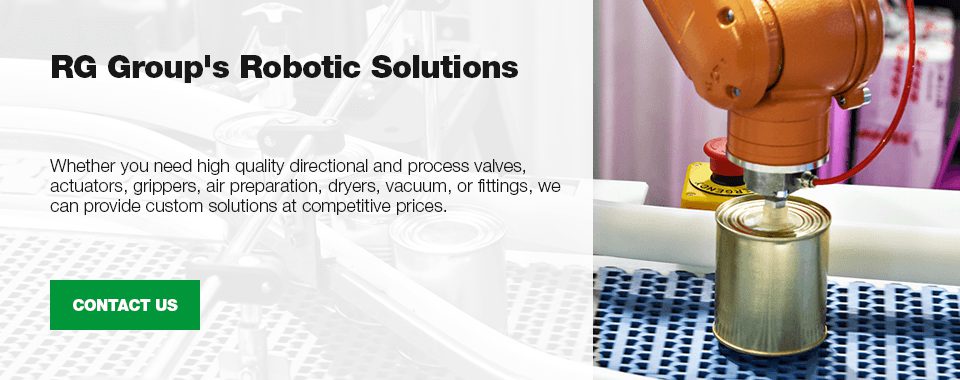
Automation and robotics are relatively new to human history yet have become integral parts of our daily operation. From automatic doors to surgical robotics, these technologies inundate nearly every industry. Automation equipment is particularly exciting for the manufacturing industry, with newer systems offering more comprehensive automation solutions. To understand the excitement surrounding the future of robotics in manufacturing, you have to understand what industrial automation means, how it developed and what it offers to modern manufacturing.
What Is Industrial Automation?
D.S. Harder, an engineering manager at the Ford Motor Company, coined the word “automation” in 1946 to describe machines that completed tasks once done by humans on the automobile production line. The term has slightly evolved over time to refer to a technology that performs specific, pre-determined processes in response to feedback without human intervention. Automation is often confused with mechanization, which refers to the replacement of human labor by machines, though automation usually accompanies mechanization.
In the manufacturing industry, industrial automation refers to the use of computer or robot-based control systems that complete processes in a manufacturing setting. Automated manufacturing systems operate inside factories and complete operations that include material handling, processing, assembly and inspection. These duties are explained briefly below:

- Material handling: These tasks are relatively simple, involving a robot moving material from one location to another. This could include machine loading and unloading, conveyor belt transfer, material arrangement and more.
- Processing: As the name suggests, this task involves a robot performing a pre-determined process to alter a part, usually using a tool. This may include tasks such as welding, spray painting, grinding or polishing.
- Assembly: Assembly is the arrangement and fixing of parts to complete a whole product. Robots are being increasingly used in the assembly process in order to reduce human labor and improve the speed of production.
- Inspection: Inspection is the visual assessment of a complete product to determine whether it meets specifications. Robots are increasingly being used in this capacity, using sensors to compare the part with specifications more quickly and thoroughly than a human can.
The takeaway with robotic automation in manufacturing is that it covers a wide range of tasks with reduced human intervention. The more advanced the industrial robot system, the less human participation involved in that system.
A Brief History of Automation
The idea of automatic devices has been around for centuries. The first known description of an automatic mechanism was created by the Greek engineer Heron of Alexandria in the first century B.C., who created an idea for automatically-opening doors using a steam-powered system. Though this design never gained traction, Khalif of Baghdad included this idea and others in his ninth-century compilation called “The Science of Ingenious Mechanisms.” This text was used by the Arab world to explore the possibilities of automation through the following centuries, though much progress was lost in the Dark Ages.
The Renaissance saw a renewed interest in automation, and Khalif’s text served as the basis for exploration of this topic. The book inspired many Renaissance scientists and thought leaders, including Leonardo da Vinci, to engage with these ideas, culminating in the creation of automatons by Swiss craftsmen in the 18th century. Though these automatons were mere moving dolls that served primarily as sources of entertainment and aesthetic appeal, they were the first stepping stone toward modern automation.
The ideas of da Vinci and other Renaissance scientists further inspired inventors of the Industrial Revolution. These inventors responded to the increasing demand for production by turning to machinery and exploring the possibilities of automation. Most notable of these inventors was Nikola Tesla, who invented many robotic models, including a robotic boat. These ideas didn’t fully come to fruition in an industrial setting, however, until the 20th century.
The Modern History of Automated Robots in Manufacturing
The first exploration of robots in the 20th century was in the arts. A play called “Rossum’s Universal Robots” premiered in Prague in 1921, featuring robots that completed human work then revolted and destroyed the earth. The play created a fear of robots that has persisted. However, this didn’t stop others from picking up and exploring the idea further. Most famously, Isaac Asimov wrote extensively about the potential implications of the widespread use of robotics, developing the fundamental laws for robotics that are still used today. In fact, Asimov’s work inspired the inventors who developed the first automated industrial robots.
George Charles Devol invented the first industrial robot in 1954, then partnered with Asimov fan and entrepreneur Joseph F. Engelberger to create robotics company Unimation. The robot they created, the Unimate, was a simple single-arm robot. It was first installed in General Motor’s factory in Trenton in 1961 to serve as a die casting machine. From there, the robotic arm gained traction across multiple industries, doing basic material handling and processing.
Industrial robot arms continued to evolve through the ’60s and ’70s, advancing with new technologies like the computer and the integrated circuit. These robots were able to replace humans for heavy, dangerous or monotonous tasks, and by the end of the 1970s, the exploration and investment in robotics skyrocketed. The 1980s saw a significant slowdown in the adoption of robotics, primarily due to inappropriate installments, manufacturing errors and other issues that caused damage to several factories. Eventually, the use of robotics picked back up, and the invention and integration of sensors has helped robotics achieve widespread use in the 21st century.
Advantages and Disadvantages of Industrial Automation
Automation has been adopted in many industrial settings, and it’s not hard to see why. Automation solutions offer manufacturing companies a wide range of advantages. Some of these advantages are explained in more detail below.

1. Higher Productivity
Even the most productive workers have their limits, and employees need time to sleep, celebrate holidays and spend with their families. The same cannot be said for a robot. While factories need three shifts to run 24/7 with human employees, robots can accomplish the same without rest or shift changes. Additionally, robots can maintain a high level of speed and accuracy as they do not tire or lose attention throughout the day. These factors mean that a company can achieve significant improvements in productivity by implementing industrial automation solutions in their manufacturing processes.
2. Shorter Lead Times
Automation helps reduce the amount of time between a customer placing an order and the product being delivered to them. Instead of waiting for human laborers to complete the process from start to finish, automated machinery can complete the same tasks in shorter amounts of time. This allows companies to edge out competitors.
3. Higher Quality
Human error is always an issue when employing human workers. Humans are limited in their accuracy and may fatigue and lose attention throughout the day, reducing their ability to maintain a high level of precision. Robots do not encounter the same problem. By automating processes, companies can achieve a higher level of accuracy and uniformity in their production, resulting in better overall product quality.
4. Reduced Waste
Higher accuracy results in fewer mistakes and fewer mistakes mean less scrap. When a human laborer makes an error, this can result in a part being scrapped or material being wasted. Automated robotic equipment will not make these kinds of mistakes, resulting in less waste. This also helps reduce material costs for companies using automated equipment.
5. Higher Flexibility
When a process is changed on the assembly line, humans may require significant training to make the change. Even if the workers are quick to pick up the new process, training can take hours out of the day, resulting in lost productivity. Robots, on the other hand, only require a change in programming to alter their processes. As a result, automation makes the manufacturing process significantly more flexible and adaptable to change.
6. Higher Information Accuracy
Modern robotics and control equipment have begun to implement automated data collection in their essential processes. This kind of data allows manufacturers to collect key production information that can help maintain and improve processes significantly. Data monitoring of this type can help identify when a machine is encountering difficulties and may need maintenance. It can also help identify bottlenecks in the manufacturing process. In short, data collection provides decision-makers with facts, enabling them to make informed decisions about their processes.

7. Improved Safety
Typically, industrial automation is used to perform jobs that are repetitive, hazardous or involve dangerous or awkward tools. All of these factors increase the danger to workers. Repetitive tasks may bore the worker and cause them to lose attention and overlook a crucial safety step, while heavy, awkward tools are more likely to be dropped or mishandled and cause injury. Industrial automation takes over these types of tasks, making the production line safer for employees. This is especially important due to the United States’ Occupational Safety and Health Act of 1970 (OSHA), which makes worker safety one of the primary concerns of any company. In fact, OSHA is one of the primary drivers for the adoption of automation in industrial settings.
8. Reduced Labor Costs
Human labor is costly — between employee training, healthcare, worker’s compensation, bonuses, pension coverage, paid leave and holidays, employees can cost companies significant amounts of money. While it will always be necessary to invest in quality personnel, companies can be empowered to reduce or redistribute labor costs through automation. Automation handles all of the time-intensive, repetitive tasks effectively and efficiently, reducing the need for humans to take on these tasks. As a result, the company may need fewer employees or be empowered to redistribute employees to other locations or specialties within the company.
9. Mitigated Labor Shortages
Holidays, illnesses or economically-caused labor shortages are a serious problem for many companies that rely on human labor in their factories. Robots, however, can never get sick and will never opt to leave your company. This means that labor availability is more consistent for companies using automated machinery.
10. Lower Operating Costs
The above advantages combine to result in improved profits and lower operating costs for companies using automation. Reduced human labor and material costs reduce the overhead involved in the production, while improved product quality and production numbers mean that more quality products are being produced and sold. Even when considering the regular maintenance required for custom automated machinery, it pales in comparison to the cost savings and profit improvements that automated machinery offers.
These advantages make automation solutions in manufacturing a highly desirable option. However, while these advantages are impressive, other factors may be considered drawbacks:
- First is the initial investment associated with implementing automation — robotic automation equipment is extremely costly by itself, but the costs rise as you include customization and installation expenditures.
- Secondly, companies have to spend time and money on training employees on how to use this new equipment properly.
- Finally, worker displacement is a factor discussed by many when it comes to automation — while workers are often retrained and placed in safer working environments, losing one’s job to a machine may cause emotional stress, especially if it may result in geographic relocation.
The Future of Robotics in Manufacturing
Even as industrial robots serve essential roles in modern manufacturing, the technology involved continues to advance. For example, artificial intelligence is expected to be the next revolutionary technology to improve the capabilities of industrial robots, allowing the robots to learn, reason, solve problems and even understand language. Artificial intelligence of this nature could allow manufacturing robots to communicate and accept high-level instructions and even take verbal commands.
RG Group’s Robotic Solutions
Automation is the way of the modern world, especially in the manufacturing industry. The numerous advantages offered by automated machinery makes it a logical step for many manufacturing companies, and many companies with existing automation are choosing to explore advanced options to keep up with competitors. The key to a successful automation integration for companies, however, is a custom solution. If your company is interested in custom automation equipment for manufacturing, RG Group can help.
RG Group is an industry leader in industrial robotics. For over 60 years, we have provided expert guidance for clients seeking innovative motion control products and solutions. We are committed to delivering comprehensive solutions for our clients seeking pneumatic and electronic automation and can provide the most comprehensive selection of products and technologies to meet your needs.
RG Group offers excellent parts from top-quality manufacturers in the industry, and we employ in-house engineers who can help specify and evaluate the products you need for your applications. Whether you need high quality directional and process valves, actuators, grippers, air preparation, dryers, vacuum, or fittings, we can provide custom solutions at competitive prices. We even offer live customer support experts to help you with your machinery after installation.
If you need custom automated machinery for your industrial application, you can trust RG Group to offer the expertise and flexibility you need to achieve a quality automation integration. Contact RG Group today to learn more about our service offerings and how we can help you achieve your automation goals.






